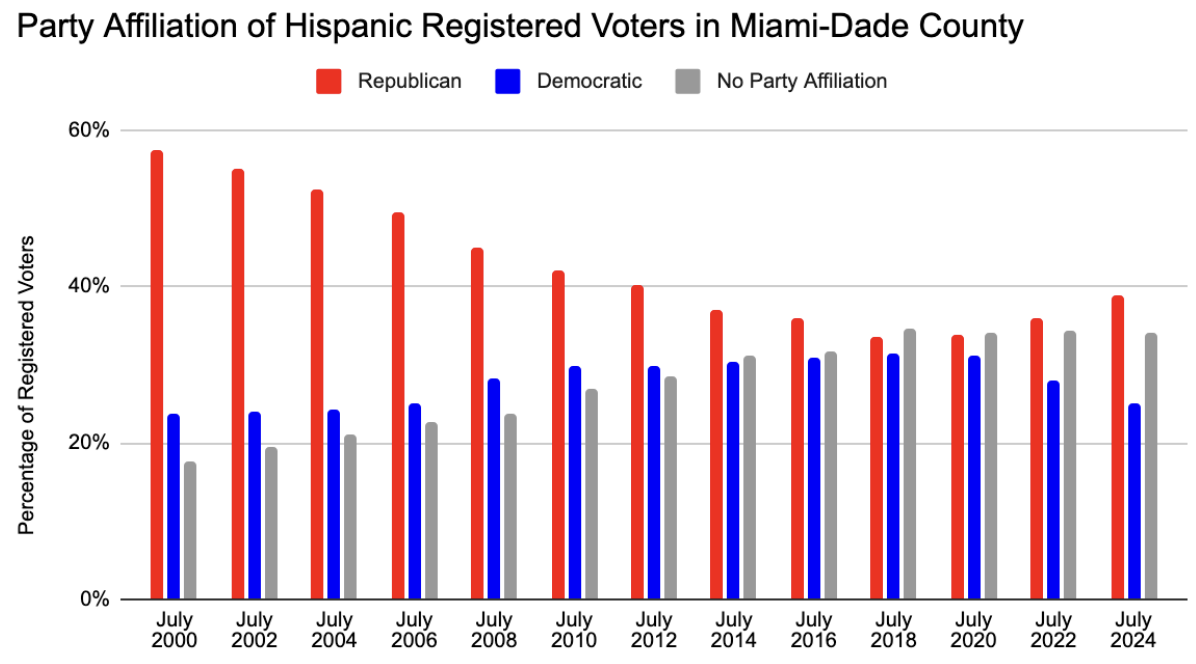How do you interpret the recent conservative shift in Miami politics?
The shift in Miami has been fascinating to watch. Anyone who knows anything about South Florida, specifically Miami-Dade County, knows that the Hispanic and Latino culture is the soul of the area. As of 2023, nearly 70% of residents in Miami-Dade County identified as Hispanic or Latino. A big part of the culture is Cuban—about 52% of residents claim Cuban origin. Cuba’s proximity to South Florida made it an ideal target for Cubans who’ve fled the island since the Communist takeover led by Fidel and Raúl Castro and Che Guevara in 1959.
That has translated to political power for the Hispanic and Latino voters in Miami-Dade County. In July 2024, approximately 61% of registered voters identified as Hispanic. Looking at voter registration statistics dating back to 2000, Hispanic and Latino registered voters have tended to be Republican. Democrats made inroads among Hispanic and Latino voters in the county during the 2000s and 2010s. Still, the share of Hispanic and Latino voters who registered as Democrats peaked in 2018 at 32% and dropped to near historic lows in July 2024.
Republicans have invested in the Hispanic and Latino communities of South Florida and offered a distinction between themselves and Democrats, particularly on economic issues. The backdrop of this is also that most of these voters either come from countries that have experienced communist rule, or have immediate family or friends who did. (Not limited to Cuba.) That also plays into the equation. Culturally, Hispanic and Latino communities are more socially conservative, and the cultural wars have arguably defined the past several years of politics.
But there are a couple of things for you to consider. First, the leading candidate for the mayor of Miami is a Democrat. (Technically, this is a nonpartisan race.) Miami-Dade County Commissioner Eileen Higgins led a field of ten candidates in a recent poll, with 36% of respondents supporting her candidacy. Another Democrat, Ken Russell, was at 12%. The Republican candidate with the most support is Emilio Gonzalez, who had 15% in the poll. Two other Republicans, Joe Carollo and Xavier Suarez, were at 11% and 7%, respectively. Nearly 20% of voters are undecided.
Higgins needs 50% plus one vote to win the election outright in November. If she takes less than a majority, the race will go to a runoff between the top two candidates. A runoff is an electoral no-man's land. It’s a turnout game. Still, the fact that Higgins is polling well is notable considering that Miami hasn’t elected a Democratic mayor since 1997.
Finally, the share of voters who registered under “no party affiliation” had increased, particularly among the Hispanic and Latino communities. Among all registered voters, 15.5% registered under “no party affiliation” in July 2000. By July 2024, the share of those voters had increased to 32%.

Among Hispanic voters, 17.7% chose “no party affiliation” in July 2000. By July 2024, the rate had increased to 34%.

This is similar to what we’re seeing nationally, with more people opting out of the Democratic and Republican parties and choosing not to be affiliated with any major party. Is it because voters are becoming more conservative? Maybe. It's possible that they were turned off by the economic message of the Democrats. Maybe Democrats’ progressive politics were too much for them. Maybe they’re turned off by the far left and the far right and have found safer ground as independents.
This is similar to what we’re seeing nationally, with more people opting out of the Democratic and Republican parties and choosing not to be affiliated with any major party. Is it because voters are becoming more conservative? Maybe. It's possible that they were turned off by the economic message of the Democrats. Maybe Democrats’ progressive politics were too much for them. Maybe they’re turned off by the far left and the far right and have found safer ground as independents.
What measures should we take to prevent gerrymandering in future elections?
Putting country over party seems like a good first step in the right direction. Blatantly partisan stuff like this is among the things that are tearing the country apart. Add to that the gaslighting from Republicans about California’s redistricting plan, which wouldn’t exist if not for Texas’s redistricting plan. It’s mind-numbingly stupid to see this play out, but here we are.
There’s a lot Congress can do in this space if the political will is there. Article I, Section 4 of the Constitution states, “The Times, Places and Manner of holding Elections for Senators and Representatives, shall be prescribed in each State by the Legislature thereof; but the Congress may at any time by Law make or alter such Regulations, except as to the Places of chusing Senators.” This means that Congress can enact laws regarding federal elections, including prohibiting of congressional gerrymandering.
I know the narrative from Democrats has been that they offered legislation to end gerrymandering. What that leaves out is that the bill they offered in 2019 and 2021 included a ban on gerrymandering, as well as many other provisions that were divisive, which is ultimately why it didn’t pass. That bill was the For the People Act in the 116th Congress and 117th Congress. The For the People Act did this by requiring states to adopt independent redistricting commissions.
We’ve heard some variation of the phrase “voters should choose their representatives and not let representatives choose their voters.” I agree with that sentiment. However, that has been happening for years. Go to Cook Political Report right now and take a gander at their House ratings. Before a single vote is cast in November 2026, Republicans are virtually guaranteed 191 seats in the House. Democrats are virtually guaranteed 175 seats. Those are the “solid” seats for both parties. I also tend to include the “likely” seats in those numbers. To see it from my perspective, assume Republicans will have 202 seats and Democrats will have 193 seats.
Put another way, party control of 91% of the seats in the House has already been determined. The remaining 9% of seats—40 districts in total—will determine which party controls Congress. Representatives have been choosing their voters for a long time, and both parties are guilty of it.
Some congressional Republicans are pushing back against their own party for the pretty blatant attempt to gerrymander a House majority. Rep. Kevin Kiley (R-CA) tweeted at Speaker Mike Johnson (R-LA) on Tuesday, urging leadership to bring his recently introduced bill to the floor to ban redistricting more than once a decade.
Will Johnson bring that bill to the floor? It’s exceedingly unlikely. Will Kiley pursue a discharge petition to force a vote on his bill? I’m skeptical that he will. Can Congress legislate in this area? Yes, and they should end gerrymandering and adopt a requirement for states to establish independent redistricting commissions. (To be clear, I haven’t reviewed the For the People Act in five years, so I’m not saying it should be that version, as I don’t remember the details of that particular provision.) Whatever bill comes to the floor must be crafted carefully and as a standalone piece of legislation. Nothing else should be attached to it.
How do you view the role of tariffs in the U.S. tax system—particularly their impact on low and middle-income consumers?
Well, first off, we’re not generating trillions of dollars in revenue from tariffs. Thus far in FY 2025, the federal government has collected $135.7 billion in customs duties. There are two months left in the fiscal year. The projection was $63.3 billion. While more revenue has been generated from customs duties, it’s not much in the grand scheme. In FY 2024, for example, 84% of the federal government's revenues were collected through individual income taxes and payroll taxes. Corporate income taxes accounted for an additional 11%. Customs duties are counted in the “other” category, which accounts for the remainder of federal revenues. Granted, customs duties will be significantly higher than in years past, but they’re still not a substantial source of revenue.
The role of customs duties will remain small in the grand scheme of federal revenue, but they’re impact will be quite measurable in other ways. Although the White House is celebrating the amount of revenue brought into federal coffers from Trump’s tariffs, this type of tax is very regressive. It hits low- and middle-class families the hardest.
Generally, consumers pay for the cost of tariffs. Certainly, some costs may be picked up along the way before the product reaches the consumer. Goldman Sachs estimates exporters and businesses will absorb about a third of the costs of the tariffs. Consumers will pick up the rest of the tab—”about two-thirds of the cost,” according to Goldman Sachs chief economist David Mericle. Consumers will begin to see those costs as the summer draws to a close.
We’re already noticing some effects of the tariffs, and inflation has increased as a result. We will see more soon. According to the Yale Budget Lab (see Figure 8), the price of clothing is expected to rise by nearly 37% in the short term, while crop prices are forecasted to go up by 32%. Importers might change their sourcing, which could lower prices, but the projected long-term increase in clothing prices is 18%. The expected long-term rise in crop prices is about 15%.
Although wealthy families will be able to adjust to the tariff, everyone else will feel a squeeze on their wallets. It’s a dangerous place for Trump and congressional Republicans, especially amid bad polling. There will be hell to pay if the administration doesn’t reverse course.





